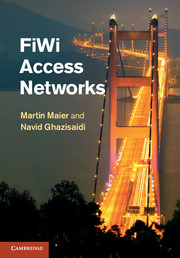Part II - Fiber access networks
Published online by Cambridge University Press: 05 January 2012
Summary
Fiber access networks have in general one of the following three architectures: (i) point-to-point architecture, (ii) active star architecture, or (iii) passive star architecture. In the point-to-point architecture, each home or building is connected to the central office (CO) via one or two dedicated fibers. This type of architecture provides improved privacy and ease of service upgrade for individual subscribers, but requires a large number of fibers and transceivers since network equipment is not shared among subscribers. As a consequence, footprint and power consumption may become serious problems at the CO. This shortcoming is avoided in star architectures, where a single feeder fiber runs from the CO to a remote node, from which individual distribution fibers branch out to connect the subscribers. The feeder fiber carries all the traffic of the attached subscribers and its cost can be shared among them. In doing so, the number of required fibers and transceivers at the CO can be reduced significantly. Depending on the nature of the remote node, the star architecture may be either active or passive. In the active star architecture, the remote node is an active device, e.g., Ethernet switch, and needs powering and maintenance. Conversely, in the passive star architecture, the active node is replaced with a passive optical splitter/combiner. Using a completely passive splitter/combiner at the remote node avoids the need for powering and maintenance and thereby helps reduce the capital expenditures (CAPEX) and in particular operational expenditures (OPEX) of fiber access networks (Koonen [2006]).
- Type
- Chapter
- Information
- FiWi Access Networks , pp. 39 - 44Publisher: Cambridge University PressPrint publication year: 2011



